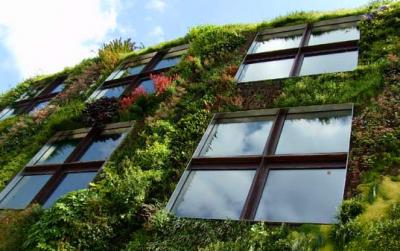 Earlier this month we talked about a japanese company making green roofs, well now you can have the roof and the walls. Patric Blanc has mastered the art of creating green walls. His hanging garden walls are simply amazing, check out his website here (warning all flash). I am not sure how environmentally friendly these things are however as you would have to water them often, but if you lived in a suitable wet climate I would guess not that often. I see this more as an interesting way to integrate more plant life into our every day life.
Earlier this month we talked about a japanese company making green roofs, well now you can have the roof and the walls. Patric Blanc has mastered the art of creating green walls. His hanging garden walls are simply amazing, check out his website here (warning all flash). I am not sure how environmentally friendly these things are however as you would have to water them often, but if you lived in a suitable wet climate I would guess not that often. I see this more as an interesting way to integrate more plant life into our every day life.
more pictures after the fold.


I’d be more concerned with the damage to the building. The web site (and boy do I hate Flash sites) states “This root-related damage can be prevented if water is regularly given to plants. Roots are then only spreadin on the surface, leaving the inner wall unaffected.”
I doubt the building owners are going to risk their investment on that.
Great idea – gotta do something about them roots.
yea i also had reservations about what this would do to the building, but there is no reason that a suitable under layer for the roots to grow into cannot be found. It seems like the guy uses a lot of felt, and some sort of panel system to keep the plants in. These plants are not your usual wall crawlers, I think he put some thought into building damage (some of the places on the site that these are installed are very expensive buildings) and besides, even the Mona Lisa is falling apart, if its minimal a little root damage wont hurt anyone.
The site also mentions free-standing walls, so root damage would not be an issue there.
Austin, Texas is a humid climate, so our systems are usually working to keep moisture out of our buildings. I wonder what effect this might have on indoor humidity? Maybe the water is entrained in the plants, so that free moisture is not that much an issue?
Gorgeous pictures.
I’ve always loved ivy-covered walls, but as mentioned above, there’s concern about damage to the building. Ivy is notorious for eating into the mortar between bricks.
Ivy can grow well though in climates with little humidity and cold winters.